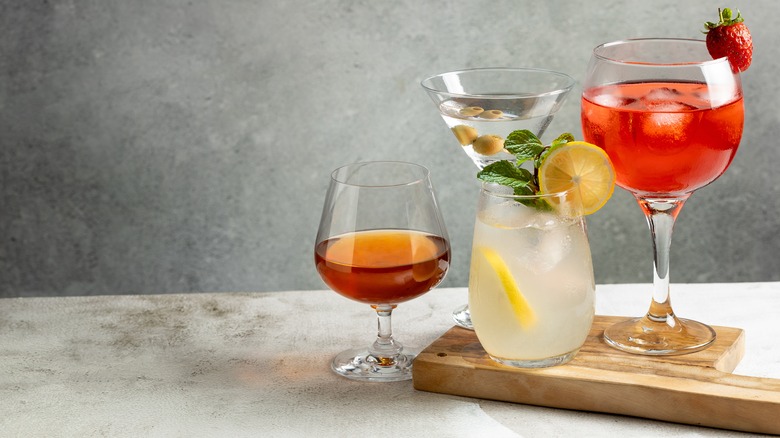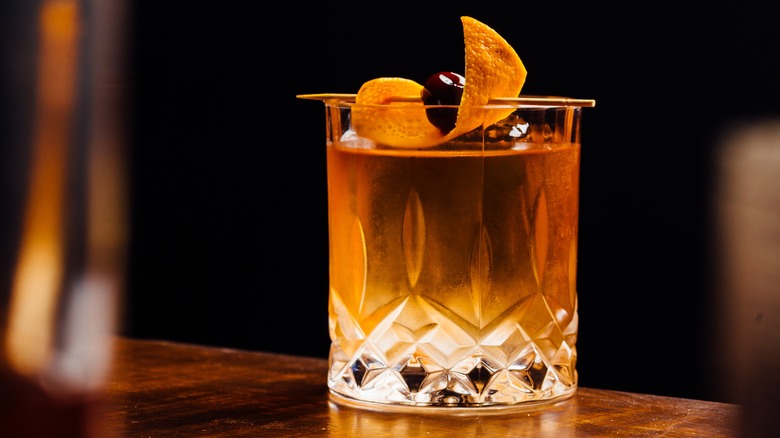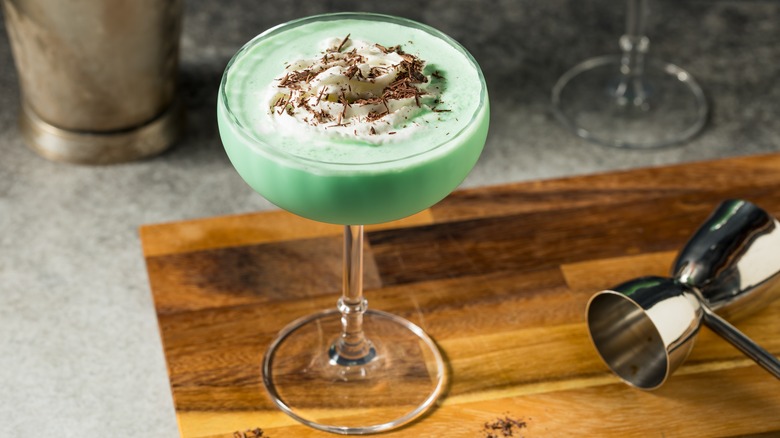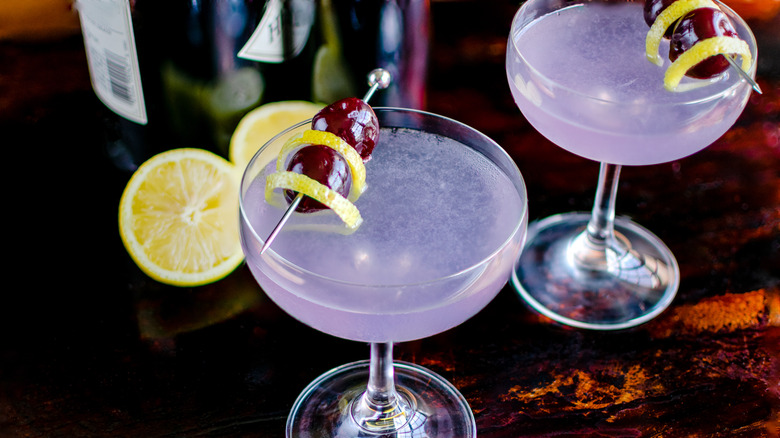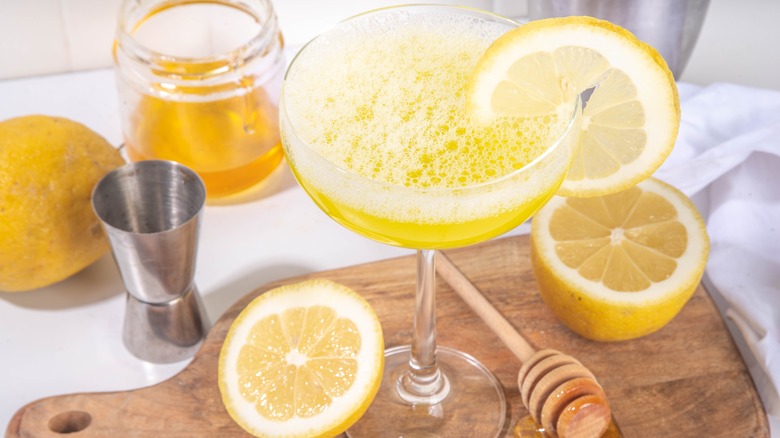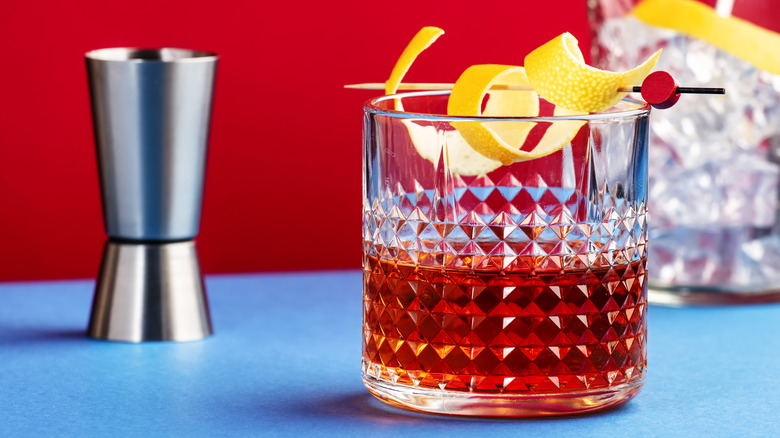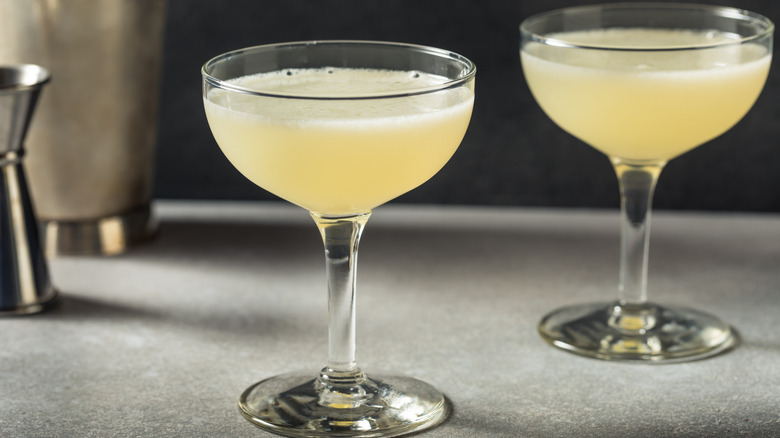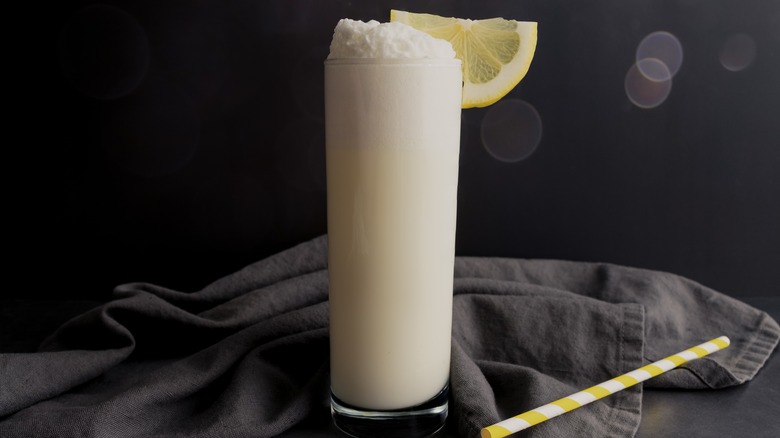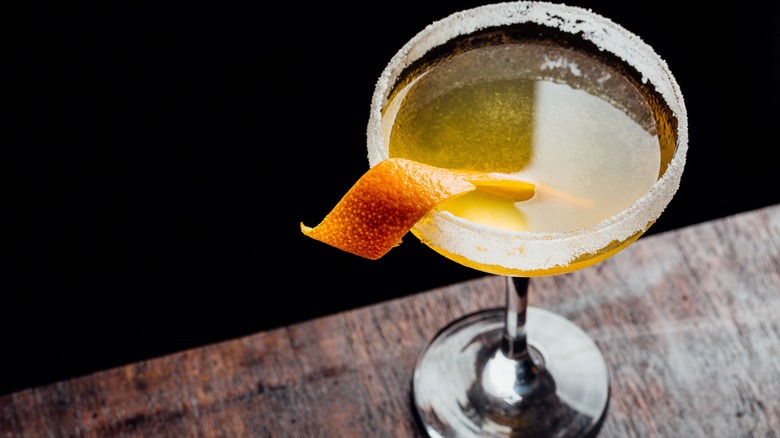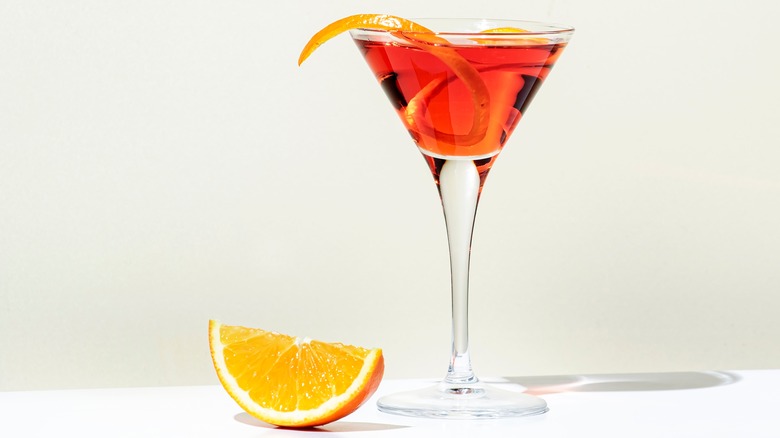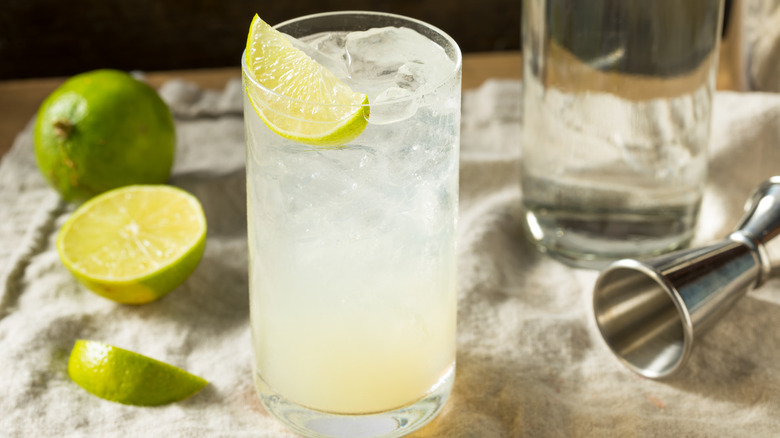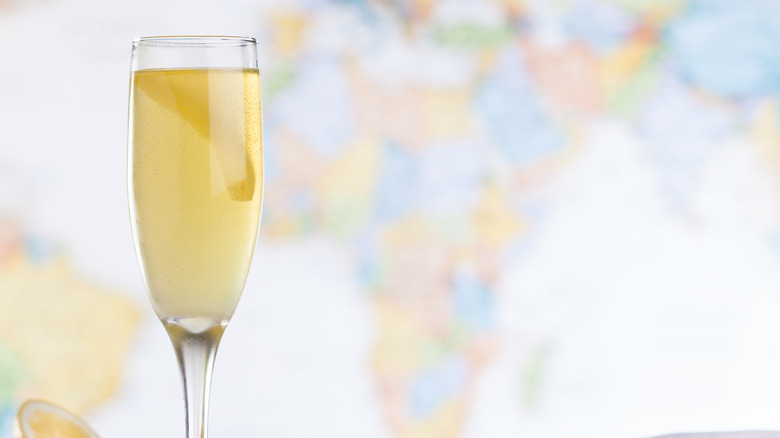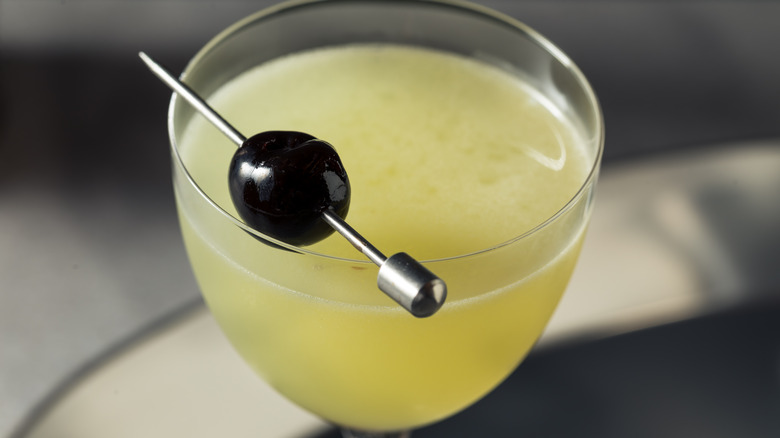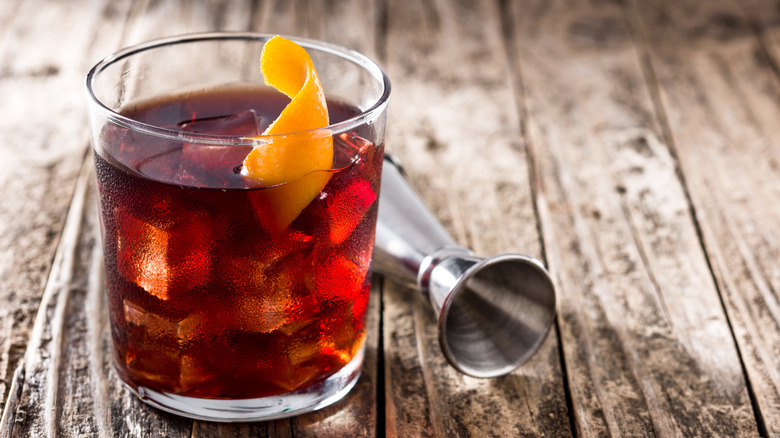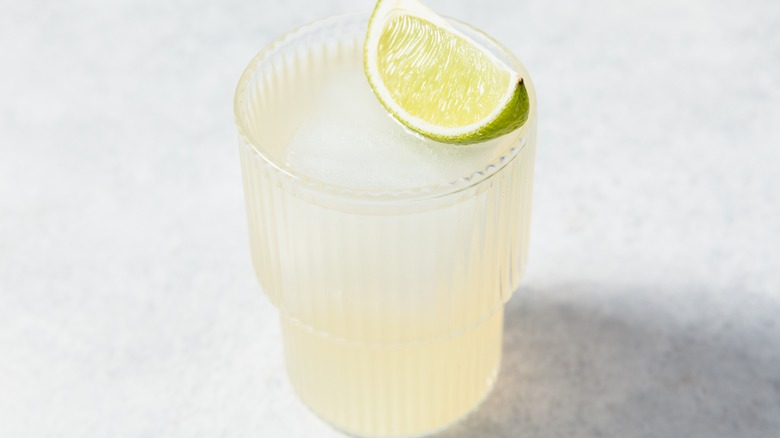These Old-School Drinks Should Get Another Round, According To A Bartender
Lots of old-school drinks have withstood the test of time, like Manhattans, daiquiris, gimlets, and more. However, quite a few tasty cocktails have now faded into the depths of history, at least in most parts of the world. While many of these once loved libations belong where they were created — in the past — a handful of them are more than worthy of a resurgence. For example, have you ever enjoyed a Bee's Knees cocktail? It's deliciously sweet, tart, citrusy, and balanced to perfection. In essence, it is a mixologist's and cocktail enthusiast's dream come true, and that's just the tip of the iceberg.
I spent 20 years working in restaurants, bars, and cocktail lounges. A couple of the spots where I tended bar specialized in pre-prohibition cocktails, too, so old-school drinks are something I know all about. While I've tasted a myriad of boozy creations that no one should have to suffer through, the old-school drinks you find below are so tasty and deliciously complex that you'll want to seek them out at a cocktail bar or start making them for yourself at home.
Old Old Fashioned
As it turns out, there are many ways to mix an old fashioned. The version most people are familiar with contains a cherry and an orange slice muddled with sugar and bitters, whiskey, and a splash of soda water. However, a more classic version is making a comeback in many circles. Often referred to as an Old Old Fashioned, it is a much simpler, and in my opinion much tastier version of the drink. It is made with a dash of Angostura bitters, a crushed cube of Demerara sugar, and 1.5 ounces of rye whiskey. The drink is served in a rocks glass, preferably with one large ice cube to ensure the alcohol is diluted as slowly as possible, and an orange swath (a twist). I also like to squeeze the orange swath and flame it to achieve the best transfer of flavor.
Unlike the old fashioned that many bars make with muddled cherry and orange in the glass, an Old Old Fashioned features rye whiskey and it isn't nearly as sweet. Many people prefer this version because the addition of fruit detracts from the complex tasting notes of the whiskey. Plus, many bars simply use maraschino cherries and they aren't very appealing because the bright red color is undeniably artificial — yuck.
Frozen Grasshopper
Deliciously sweet and colorful, the Grasshopper cocktail is a true delight. Originally, it was simply made as a creamy martini, with equal parts creme de menthe, creme de cacao, and heavy cream. However, when it is constructed as a boozy milkshake, no one can resist its charms. Supposedly, the Grasshopper was first invented by Philibert Guichet in 1918 during a drink competition. It was tasty enough to earn him second place so he quickly added it to Tujague's menu in New Orleans and the rest is history.
Thanks to its refreshing minty, chocolaty, creamy taste, the Grasshopper is the perfect dessert drink. You probably won't want more than one because it is quite heavy, but even so, it is a delicious after-dinner cocktail all the same. I like to make the drink somewhat different from the original recipe. Instead of using cream, I opt for vanilla ice cream and instead of creme de cacao, I often reach for chocolate syrup. I still use creme de menthe and a few leaves of fresh mint but these minor changes help it stay frozen for longer and give it the dessert-like quality many people love.
This drink isn't the easiest to order at a bar because it requires a blender, something a lot of bars don't have. It is also a messy drink to make, but I think its yummy flavors are worth the extra cleanup.
Aviation
The Aviation cocktail is one of those drinks that people see bartenders making and ask about because it has a unique color that ranges from deep purple to light blue (depending on the season and the color of the flowers). In addition to its eye-catching appeal, it also has a delightfully complex flavor with lots of botanical elements and notes of fruit and citrus, so it's pleasing to the palate, as well. An Aviation's yummy taste is created with 2 ounces of gin, ½ ounce of maraschino liqueur, ¼ ounce of creme de violette, and ¾ ounce of fresh lemon juice. The ingredients are shaken with ice and served in a martini glass with a cherry garnish.
One of the reasons this cocktail is not super popular is because maraschino liqueur and creme de violette are not commonly stocked in most bars. In fact, creme de violette was pretty hard to track down in the United States until it started being imported again in 2007. Today, it is worth seeking out these unique liquors, especially if you are a gin drinker. One of the cocktail bars I worked in made Aviations and they were a huge hit. I remember many people marveling at the delicate yet robust flavors when tasting it for the very first time.
Bee's Knees
The Bee's Knees cocktail first got its start at the Hotel Ritz Paris in the 1920s. An Austrian-born bartender Frank Meier is credited with its invention and since its inception in the Prohibition era it has become wildly popular in some mixologist scenes, Denver included (where I spent many years working). Still, it isn't quite as popular as it should be and it's long overdue for a full-blown resurgence.
A Bee's Knees is a simple yet flavorful martini-style cocktail made with 2 ounces of gin, ¾ ounce of fresh lemon juice, and ½ ounce of honey. Served straight up with a lemon swath, it is sweet, bright, and potent, giving it all the punch you'd want from a martini without any of the burn.
A Bee's Knees may be super easy to make, but don't let that fool you. Its smooth, light taste makes it a surefire winner for all kinds of drinkers. I'll admit, I wasn't always a big fan of gin, but this is the drink that changed my mind about the spirit. It is beautifully balanced and the overwhelming citrus notes pair with the botanical elements of gin in ways I didn't think were possible. Seriously, it's delicious by any standards.
Sazerac
The Sazerac is known as the official cocktail of New Orleans. It is rumored to have been invented in 1838 by a Creole apothecary named Antoine Peychaud (yes, from the bitters brand), but this is highly disputed. Regardless of how it first came about, it is synonymous with the unique flavors and bold characteristics associated with the city in which it was born. A Sazerac cocktail is made with 2 ounces of rye whiskey (cognac is also an option), three dashes of Peychaud's bitters, and ½ teaspoon of simple syrup. It is served chilled and neat in a rocks glass that has been rinsed with absinthe. It is then finished off with a lemon swath garnish. The resulting flavor is quirky, smooth, and unexpected in all the right ways.
There was a time when tracking down a bottle of absinthe wasn't easily accomplished because it was banned in the United States in 1912, but today you shouldn't have any issues. It's been legal since 2007 and can now be found in an array of cocktails, like the Sazerac. Of course, there were also rumors that the wormwood in absinthe makes you hallucinate but don't expect it to take you on a trippy adventure, either.
Corpse Reviver No. 2
As the name suggests, a Corpse Reviver No. 2 is boldly potent and, well, strong enough to wake the dead. In the pre-Prohibition era (it has been around since at least the 1870s), it was apparently used to help cure hangovers — a little hair of the dog anyone? Whether it truly sets you straight after a rowdy night or not, it is definitely a great way to get your day or evening started.
A Corpse Reviver No. 2 is made by mixing equal parts (¾ ounce each) gin, Lillet blanc, orange liquor, and fresh lemon juice in a shaker with ice. Then, it is given a good shake and poured into an absinthe-rinsed glass. Thanks to the lemon and orange, it has an ultra-smooth taste but still manages to pack quite the punch alcohol-wise. It was a favorite of brunch patrons at a place where I worked, although it was deceivingly strong, too.
Ramos Gin Fizz
You'll never hear a bartender say they love making a Ramos Gin Fizz (they aren't easy), but that doesn't mean they aren't delicious. In fact, they are super yummy, and they look drool-worthy from a distance too. Its list of ingredients includes 2 ounces of gin, ¾ ounce of simple syrup, ½ ounce of heavy cream, ½ ounce of both fresh lemon and lime juice, three dashes of orange flower water, an egg white, and soda water. All of the elements except for the soda water are combined in a shaker and vigorously agitated to form a super fluffy drink. Then, it is poured into a tall glass and then topped with soda until the foam reaches high above the glass's rim.
Originally mixed in New Orleans in 1888 by Charles Ramos, the Ramos Gin Fizz is another one of those drinks that people are drawn to by appearance. As a bartender, I quickly learned that if someone ordered one the simple sight of it was enough to make several more follow suit. This is fine and all but its precarious foam and need for the ultimate fluffy texture make this drink labor-intensive. It also contains a lot of ingredients, so it is anything but quick to whip up.
If you try making a Ramos gin fizz at home, you'll have to shake extra hard and fast for about 45 seconds. If you don't, the foam won't froth correctly and your drink will fall flat, both literally and figuratively.
Sidecar
The origins of a sidecar are somewhat disputed but it first became popular in London and Paris in the 1920s. Since then, its simple construction and appealing flavors have cemented its place in the world of mixology. For anyone who hasn't had the pleasure of tasting a Sidecar, it is a warm, citrusy, refreshing martini-style drink perfect for anyone who likes brown liquors.
As noted, the sidecar is quite easy to make. It only contains three ingredients: Cognac or brandy, lemon juice, and orange liquor. The ingredients are shaken with ice and then served up in a martini glass with a sugar rim. When it comes to selecting your booze, Cointreau is the standard orange liqueur used. As far as the main liquor, Cognac is traditional, but I think brandy works just as well. After all, they are basically the same thing. Cognac just comes from a specific region in France. To mix one up yourself, combine 2 ounces of Cognac, one ounce of Cointreau, and ¾ ounce of fresh lemon juice in a cocktail shaker, add ice, and shake vigorously. Then, pour your mix into a sugar-rimmed martini glass and enjoy.
For a fun twist, you can easily turn a sidecar into a drink called Between The Sheets with the addition of white rum. Of course, the measurements will change a bit, too, but I love this rendition of the drink for its lighter taste. The white rum also cuts through the cognac in an uplifting way.
Martinez
If you haven't caught on yet, I have a thing for martinis from the pre-Prohibition era, and the Martinez stays true to my brand. We'll probably never know the exact origin of the Martinez cocktail, but suffice it to say it was first printed in a cocktail guide in 1884. While it has since faded into the pages of history, it can still be found at some bars around the country, even if it is not very popular overall. I think we should bring it back though because it is pleasingly sweet and layered with herbaceous flavors.
A Martinez is made with equal parts gin and Carpano Antica sweet vermouth (1½ ounces of each), ½ ounce of maraschino liqueur, and two dashes of orange bitters. The ingredients are mixed in ice, stirred, and served in a coupe glass with an orange swath. Pro tip: If you go to a bar and see an Aviation on the menu, the bartenders probably know how and are capable of making you a Martinez, as well (because they have to stock maraschino liqueur).
Gin Rickey
A Gin Rickey may be quick and easy to concoct, but its beauty lies in its simplicity. All you need to make one is 2 ounces of gin, 1 ounce of lime juice, ¾ ounce of simple syrup, and soda water. All of the ingredients are added to a collins glass with ice and it is garnished with a lime wedge — it's that simple. The addition of lime and simple syrup to just about any spirit makes a fantastic choice, as is evident by drinks like mojitos, Moscow mules, and more. Plus, a little bit of bubbles goes a long way in making a well-rounded cocktail.
While a Gin Rickey is perfectly tasty and effortless as is, you can also turn it into a Tritter's Rickey with the addition of a mint sprig garnish and an absinthe rinse for the glass. The mint is just for show, but the absinthe definitely shines through, so only try this if you really enjoy a strong licorice flavor.
French 75
Hailing from the peak of the Prohibition era, The French 75 is one of my all-time favorite Champagne cocktails. It is easy and quick to make, has lots of flavor, and I love the effervescence of the bubbles, too. A French 75 is made with 1 ounce of gin, a ½ ounce of simple syrup, ½ ounce of fresh lemon juice, and 3 ounces of Champagne (or however much you need to fill the flute). For a finishing touch, it gets a lemon twist as a garnish.
For the most part, any bartender worth their snuff will chill the gin, simple syrup, and lemon juice before adding sparkling wine, but I've known a few who don't. I recommend committing to the extra step if you try making a French 75 at home though because it helps keep the drink colder for significantly longer, obviously. Some people even make a French 75 with cognac, but I prefer the gin version myself because it is much lighter in taste, and color for that matter.
The Last Word
If you like uniquely flavored cocktails that arouse the senses and tantalize the palate, The Last Word might just be your new favorite cocktail. Made with 1 ounce of gin, 1 ounce of maraschino liqueur, 1 ounce of green Chartreuse, and 1 ounce of lime juice, it is a true party for your tastebuds. Of course, it doesn't hurt that it's super strong either. If you've never tasted Chartreuse before, it's boldly herbaceous, peppery, and unlike anything else. No one is exactly sure what the 130 plants, roots, barks, spices, and flowers that go into are, but it's deliciously wild, to say the least.
I can argue that The Last Word is due for a resurgence, but the fact is, it kind of already had one. Plus, the Carthusian monks who make it have severely limited production (only about 1.2 million are produced annually), so it can be challenging to get your hands on a bottle. If you are lucky enough to find one, make sure to grab it. Who knows when you'll have the opportunity again.
Boulevardier
The Boulevardier is a fantastic cocktail for anyone who likes negronis and bourbon (it is basically the same thing but switches out gin for bourbon). Since Negronis are becoming more and more popular every day, I think the Boulevardier deserves another look as well. It is made with 1½ ounces of bourbon or rye whiskey, ¾ ounce Campari, and ¾ ounce sweet vermouth. The ingredients are mixed together and served over one large ice cube with an orange swath for a garnish. The resulting drink is complex, warm, and uniquely tart and sweet all at once.
Unlike a classic negroni, which is bold and crisp, the Boulevardier leans more toward the rich and warming side. As such, it makes a wonderful choice for chilly weather. Even so, it was a favorite of bourbon drinkers in one of my previous places of employment all year long. I think it's ideal for experimental drinkers looking to dip their toes in the world of layered mixologist cocktails.
Death In The Gulf Stream
Ernest Hemingway may be known for his writing, but he was a legendary drinker, as well. As such, there are several drinks associated with this famous author of the past, one of which is called Death In The Gulf Stream. Served in a Collins glass, this old-timey cocktail is made with 2 ounces of Genever (Dutch gin), 1 ounce of lime juice, four dashes of Angostura bitters, and the zest from one lime. Many people also include a ½ ounce of simple syrup as well because the drink would be pretty tart without it, but it is optional. Of course, the measurements for each ingredient may vary from one mixologist to the next as well, but this ratio works quite well.
When mixed, shaken, and poured over ice, Death In The Gulf Stream is refreshing, slightly botanical, and ranges from sour to slightly sweet depending on how much simple syrup you add. It is a fantastic drink for hot summer days or any time you want something flavorful, light, and refreshing.
If you've never encountered Genever before, it is essentially gin from Holland. Like gin, it is made with juniper, but unlike gin, it contains malt wine in addition to a neutral spirit infused with botanicals. Think of it like gin fused with whiskey but much more subtle in taste.

